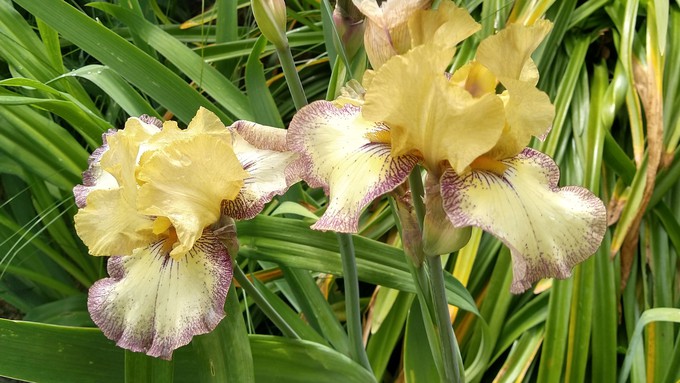
Bearded irises are a perfect addition to water-wise Sacramento gardens

'Tennessee Gentleman' is one of the many colorful and unusual bearded iris varieties that the Sacramento Iris Society has offered at past rhizome sales. Find some stunning additions for your water-wise garden. Debbie Arrington
Here’s a wonderful opportunity to add a rainbow of color to your water-wise garden: The annual iris rhizome sale.
Saturday and Sunday, July 15 and 16, the Sacramento Iris Society will host its annual rhizome sale at Shepard Garden and Arts Center. These are newly dug rhizomes – fresh from the ground, divided, trimmed and ready to replant.
Mid to late summer is perfect for planting bearded iris rhizomes, so this sale’s timing could not be better – even with triple-digit temperatures forecast for this weekend. (Shepard Center is air-conditioned.) Shop early for best selection; sale hours are 9 a.m. to 4 p.m. Saturday and 9 a.m. to 3 p.m. Sunday. Admission and parking are free.
Hundreds of varieties will be available. According to the society, each specimen will be labeled with the cultivar name and a description of the flower appearance.
Besides the traditional spring bloomers, find a large selection of “rebloomers” that extend iris season into summer and fall. Get advice on how to plant rhizomes and year-round iris care.
Why plant irises? Besides the beautiful flowers, they’re an ideal choice for Sacramento and foothill gardens. Bearded irises are both deer and drought resistant; they can coexist with wildlife and need little summer irrigation.
Shepard Center is located at 3330 McKinley Blvd., Sacramento, in McKinley Park.
Details and directions: www.sgaac.org.
Comments
0 comments have been posted.Sacramento Digs Gardening to your inbox.
Sites We Like
Garden Checklist for week of April 21
This week there’s plenty to keep gardeners busy. With no rain in the immediate forecast, remember to irrigate any new transplants.
* Weed, weed, weed! Get them before they flower and go to seed.
* April is the last chance to plant citrus trees such as dwarf orange, lemon and kumquat. These trees also look good in landscaping and provide fresh fruit in winter.
* Smell orange blossoms? Feed citrus trees with a low dose of balanced fertilizer (such as 10-10-10) during bloom to help set fruit. Keep an eye out for ants.
* Apply slow-release fertilizer to the lawn.
* Thoroughly clean debris from the bottom of outdoor ponds or fountains.
* Spring brings a flush of rapid growth, and that means your garden is really hungry. Feed shrubs and trees with a slow-release fertilizer. Or mulch with a 1-inch layer of compost.
* Azaleas and camellias looking a little yellow? If leaves are turning yellow between the veins, give them a boost with chelated iron.
* Trim dead flowers but not leaves from spring-flowering bulbs such as daffodils and tulips. Those leaves gather energy to create next year's flowers. Also, give the bulbs a fertilizer boost after bloom.
* Pinch chrysanthemums back to 12 inches for fall flowers. Cut old stems to the ground.
* Mulch around plants to conserve moisture and control weeds.
* From seed, plant beans, beets, cantaloupes, carrots, corn, cucumbers, melons, radishes and squash.
* Plant onion sets.
* In the flower garden, plant seeds for asters, cosmos, celosia, marigolds, salvia, sunflowers and zinnias.
* Transplant petunias, zinnias, geraniums and other summer bloomers.
* Plant perennials and dahlia tubers for summer bloom.
* Mid to late April is about the last chance to plant summer bulbs, such as gladiolus and tuberous begonias.
* Transplant lettuce seedlings. Choose varieties that mature quickly such as loose leaf.